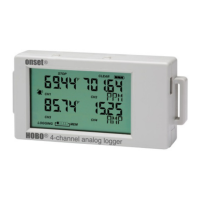Chapter 3: Understanding the logger
HOBO Energy Logger Pro User’s Guide 13
Battery life
Battery life will vary with the following factors:
• Sensor excitation current and warmup time (most important factor)
• Logging interval (and sampling interval, if applicable) selected
• Number of sensors being used
• Battery type
• Operating environment (e.g., temperature)
The following graph can help you estimate how long batteries will last (the run time) at different logging intervals
and excitation currents with a warmup time of 30 seconds.
Logging Interval
0.1
1.0
10.0
100.0
1000.0
1 21 41 61 81 101 121 141 161 181
Excitation Current (mA)
Battery Life (days)
1 Min 5 Min 10 Min 1 Hr
Note: This graph assumes that standard alkaline batteries and three FlexSmart modules are being used.
This graph was generated from a spreadsheet that can estimate battery life for varying parameters. Contact Onset
Technical Support for more information.
Maximizing battery life
• Batteries are inexpensive compared to the cost of a new logger or a missed logging opportunity. If you
suspect that batteries are damaged or run down, replace them immediately to prevent leakage or logger
malfunction.
• When launching the logger in HOBOware Pro, do not set a
Sampling Interval unless you have sensors that
support measurement averaging. Only the following Smart Sensors and input adapters support
measurement averaging:
- 12-bit Temperature S-TMB-M0XX
- 12-bit 4-20 mA Input Adapter (S-CIA-CM14)
- 12-bit Voltage Input Adapter (S-VIA-CM14)
- Photosynthetically Active Radiation (PAR) S-LIA-M003
- Silicon Pyranometer (Solar Radiation) S-LIB-M003
Tip: Keep in mind that although some Smart Sensors are intended mainly for outdoor use (for example,
the PAR and Solar Radiation sensors), the Energy Logger Pro is suitable for indoor use only.
• If you are using excitation voltage, select the shortest warmup time needed for the sensor.

